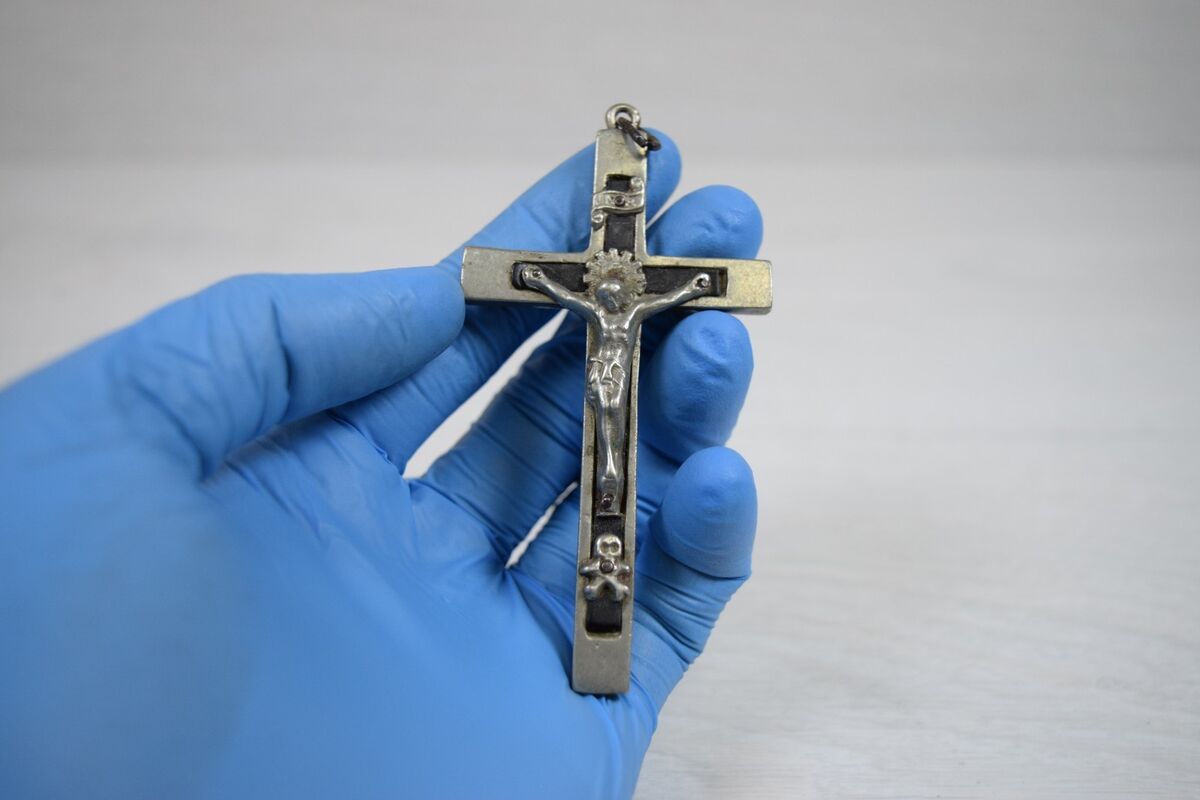
Did you know that Bulgaria is home to the oldest Christian amulet ever found? Unearthed in 2023 at the Deultum-Debelt National Archaeological Reserve, this 1,800-year-old silver artifact offers a fascinating glimpse into early Christian practices. Discovered in a Roman-era necropolis, the amulet features inscriptions referencing Jesus Christ and the archangels Gabriel and Michael. Its discovery sheds light on how early Christians secretly practiced their faith within the Roman Empire. This ancient relic, once hidden in a grave, now stands as a testament to the enduring power and spread of Christianity in Southeastern Europe. Curious to learn more? Let's dive into the details of this remarkable find.
Key Takeaways:
- The discovery of a 1,800-year-old Christian amulet in Bulgaria sheds light on early Christian practices and the secretive nature of their worship, offering valuable insights into ancient history and beliefs.
- The amulet's inscriptions and symbolism reveal the significance of Christ and archangels in early Christian theology, highlighting the challenges and resilience of early Christian communities in Bulgaria.
Discovery of the Oldest Christian Amulet in Bulgaria
In 2023, archaeologists unearthed a remarkable artifact in Bulgaria, shedding light on early Christian practices. This silver amulet, found in an ancient Roman necropolis, offers a glimpse into the secretive world of early Christianity.
-
The silver amulet was discovered in the Deultum-Debelt National Archaeological Reserve, near the village of Debelt in southeastern Bulgaria.
-
It was found in a Roman era necropolis, the site of an ancient Roman colony known as Deultum, established in the 1st century AD for retired Roman legion veterans.
-
The amulet dates back to the late second or early third century AD, making it approximately 1,800 years old.
-
Clearly Christian in nature, the amulet features inscriptions referencing Jesus Christ and the archangels Gabriel and Michael.
Inscriptions and Symbolism
The inscriptions on the amulet reveal much about early Christian beliefs and practices. They provide clues about how early Christians expressed their faith.
-
The inscription includes lines dedicated to Christ, Gabriel, and Michael, along with the ancient Greek word for ‘Guardian,’ believed to refer to Christ.
-
Christ’s name is written in Greek at the top, with the first letter, X, rotated 45 degrees to form a cross, a common early Christian symbol.
-
Early Christians used symbols to refer to Christ without arousing suspicion. This amulet, placed in a grave, allowed for a direct mention of Christ.
-
The amulet was found rolled up near the head of a young man, suggesting it was meant to protect the deceased in the afterlife.
Material and Preservation
The amulet's material and preservation state offer insights into ancient craftsmanship and burial practices.
-
Made of silver, the amulet was well-preserved despite being nearly 2,000 years old. Initially thought to be a massive silver ingot, it was later found to be a tightly rolled thin sheet.
-
It was likely housed in a leather or fabric holder, worn around the neck or hidden in clothing.
Archaeological and Historical Significance
This discovery is significant for understanding early Christian practices and the spread of Christianity in the Roman Empire.
-
The amulet provides invaluable insight into early Christian practices, highlighting the secretive nature of their worship.
-
During the Roman era, Christianity was a minority religion, often practiced in secret. This amulet is one of the few artifacts explicitly referencing Christ.
-
Renowned epigrapher Dr. Nikolay Sharankov, along with experts from the Deultum-Debelt National Archaeological Reserve, deciphered and translated the inscription.
-
The inscription includes Greek lines such as “Gabriel, Michael, the Guardian – Christ,” reflecting the influence of Greek language in early Christianity.
Role of Archangels and Christ
The mention of archangels and Christ underscores their importance in early Christian theology.
-
The amulet mentions archangels Gabriel and Michael, significant figures in early Christian beliefs.
-
Christ’s name is written as +ΡЄICTOC, with the first letter X forming a cross, symbolizing Christ’s role as a protector.
-
The word ‘Guardian’ (ΦΥΛΑΞ) likely refers to Christ, emphasizing the amulet’s purpose as a protective charm.
Early Christian Communities and Roman Influence
The discovery highlights the existence of early Christian communities and the role of the Roman Empire in spreading Christianity.
-
The amulet shows early Christian communities practiced their faith in secret, using symbols and codes to avoid persecution.
-
Roman veterans in colonies like Deultum facilitated the spread of Christian beliefs among local populations.
-
Christianity was practiced in Bulgaria throughout the pagan period, with Khan Krum’s wars in the 9th century increasing Christian influence.
Bulgarian Rulers and Christianity
The relationship between Bulgarian rulers and Christianity was complex, reflecting the religion's growing influence.
-
Despite initial persecution, Christianity spread in Bulgaria. Rulers like Khan Omurtag viewed it as a threat but acknowledged its influence.
-
The First Bulgarian Empire (7th-11th centuries AD) played a crucial role in Christianity’s development, with rulers gradually adopting the faith.
-
The Philippi Inscription of Khan Presian (837 AD) reflects the elite’s perception of Christianity as a powerful force.
Early Christian Martyrs and Saints
The early Christian period in Bulgaria saw many martyrs, highlighting the faith's challenges and resilience.
-
Many Christians were martyred for their faith, including both Bulgar and Slav names, reflecting diverse early Christian communities.
-
Enravota, Khan Omurtag’s eldest son, converted to Christianity and was executed for refusing to renounce his faith, becoming Bulgaria’s first saint.
Archaeological Park Deultum-Debelt
The Deultum-Debelt National Archaeological Reserve offers a treasure trove of artifacts, providing insights into ancient life.
-
The site has yielded medical instruments, children’s toys, jewelry, ceramics, military equipment, and musical instruments.
-
The silver amulet is now displayed in the museum of the Deultum-Debelt National Archaeological Reserve, allowing visitors to appreciate its historical significance.
-
The amulet’s preservation is a testament to careful excavation and conservation practices.
Symbolic Features and Early Christian Symbolism
The amulet’s symbolic features highlight the importance of symbols in early Christian worship.
-
The cross in Christ’s name is a symbolic feature found in other early Christian inscriptions, emphasizing the cross’s importance.
-
Early Christians often used innocuous symbols like birds or fish to refer to Christ. This amulet, however, explicitly mentions Christ.
Roman Influence on Christianity and Bulgarian Folklore
The Roman Empire’s influence on Christianity and Bulgaria’s rich folklore reflect the region’s deep cultural heritage.
-
Roman veterans in colonies like Deultum played a crucial role in spreading Christian beliefs.
-
Bulgarian folklore includes mythological beings from the Slavic pantheon, reflecting the country’s cultural heritage.
-
Slavs worshipped numerous deities, with Perun, the god of thunder and lightning, being the supreme deity.
Christianity in Southeastern Europe
The amulet highlights the spread of Christianity in Southeastern Europe, a region crucial to early Christian development.
-
Southeastern Europe played a crucial role in early Christianity, with communities practicing their faith in secret until it became more accepted.
-
The silver amulet is a testament to the region’s rich cultural and historical significance, providing insights into early Christian practices and the secretive nature of their worship.
The Significance of Bulgaria's Christian Amulet
The discovery of Bulgaria's oldest Christian amulet is a game-changer for understanding early Christian practices. Found in the Deultum-Debelt National Archaeological Reserve, this 1,800-year-old silver artifact offers a rare glimpse into the secretive world of early Christians. With inscriptions referencing Jesus Christ and archangels Gabriel and Michael, the amulet highlights the protective and symbolic nature of early Christian worship.
Its well-preserved state and detailed inscriptions make it a crucial piece of historical evidence, shedding light on the spread of Christianity in the Roman Empire. The amulet's discovery underscores the rich cultural and religious history of Bulgaria, revealing how early Christians navigated their faith amidst persecution. This artifact not only enriches our understanding of early Christian communities but also emphasizes the enduring impact of Christianity on Bulgarian culture and heritage.
Frequently Asked Questions
Was this page helpful?
Our commitment to delivering trustworthy and engaging content is at the heart of what we do. Each fact on our site is contributed by real users like you, bringing a wealth of diverse insights and information. To ensure the highest standards of accuracy and reliability, our dedicated editors meticulously review each submission. This process guarantees that the facts we share are not only fascinating but also credible. Trust in our commitment to quality and authenticity as you explore and learn with us.


